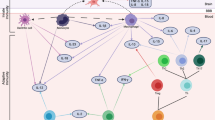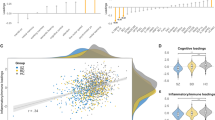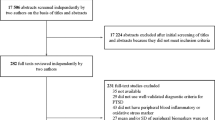Abstract
Posttraumatic stress disorder (PTSD) has been shown to be associated with pro-inflammatory markers, including elevated plasma levels of interleukin-1β (IL-1β). However, the precise role of neuroinflammation and central immune signaling on the development of this debilitating psychological disorder is not known. Here, we used stress-enhanced fear learning (SEFL), an animal model of the disorder, to examine the role of central IL-1β in PTSD. The results show that the severe stressor in SEFL induces a time-dependent increase in IL-1β immunoreactivity and mRNA expression within the dentate gyrus of the dorsal hippocampus (DH). There was no increase in IL-1β in the basolateral amygdala or the perirhinal cortex. Moreover, blocking the action of IL-1β following the severe stressor with IL-1 receptor antagonist (10 μg, intracerebroventricular (i.c.v.), 24 and 48 h after the stressor) prevented the development of SEFL. To provide further support for the role of IL-1β in the development of SEFL, we show that systemic morphine, a treatment which is known to reduce both PTSD and SEFL, also reduces IL-1β expression in the DH induced by the severe stressor. These studies provide the first evidence that IL-1 is involved SEFL and suggest that IL-1 signaling in the brain may have a critical role in the development of PTSD.
Similar content being viewed by others
Log in or create a free account to read this content
Gain free access to this article, as well as selected content from this journal and more on nature.com
or
References
Acheson DT, Gresack JE, Risbrough VB (2012). Hippocampal dysfunction effects on context memory: possible etiology for posttraumatic stress disorder. Neuropharmacology 62: 674–685.
Anagnostaras SG, Gale GD, Fanselow MS (2001). Hippocampus and contextual fear conditioning: recent controversies and advances. Hippocampus 11: 8–17.
Avital A, Goshen I, Kamsler A, Segal M, Iverfeldt K, Richter-Levin G et al (2003). Impaired interleukin-1 signaling is associated with deficits in hippocampal memory processes and neural plasticity. Hippocampus 13: 826–834.
Bai YM, Su TP, Tsai SJ, Wen-Fei C, Li CT, Pei-Chi T et al (2014). Comparison of inflammatory cytokine levels among type I/type II and manic/hypomanic/euthymic/depressive states of bipolar disorder. J Affect Disord 166: 187–192.
Brennan FX, Beck KD, Servatius RJ (2004). Proinflammatory cytokines differentially affect leverpress avoidance acquisition in rats. Behav Brain Res 153: 351–355.
Bryant RA, Creamer M, O'Donnell M, Silove D, McFarlane AC (2009). A study of the protective function of acute morphine administration on subsequent posttraumatic stress disorder. Biol Psychiatry 65: 438–440.
Dantzer R (2001). Cytokine-induced sickness behavior: where do we stand? Brain Behav Immun 15: 7–24.
Depino AM, Alonso M, Ferrari C, del Rey A, Anthony D, Besedovsky H et al (2004). Learning modulation by endogenous hippocampal IL-1: blockade of endogenous IL-1 facilitates memory formation. Hippocampus 14: 526–535.
Fanselow MS, Dong HW (2010). Are the dorsal and ventral hippocampus functionally distinct structures? Neuron 65: 7–19.
Flannery S, Bowie AG (2010). The interleukin-1 receptor-associated kinases: Critical regulators of innate immune signalling. Biochem Pharmacol 80: 1981–1991.
Frankland PW, Bontempi B (2005). The organization of recent and remote memories. Nat Rev Neurosci 6: 119–130.
Gill JM, Saligan L, Woods S, Page G (2009). PTSD is associated with an excess of inflammatory immune activities. Perspect Psychiatr Care 45: 262–277.
Goshen I, Kreisel T, Ben-Menachem-Zidon O, Licht T, Weidenfeld J, Ben-Hur T et al (2008). Brain interleukin-1 mediates chronic stress-induced depression in mice via adrenocortical activation and hippocampal neurogenesis suppression. Mol Psychiatry 13: 717–728.
Goshen I, Kreisel T, Ounallah-Saad H, Renbaum P, Zalzstein Y, Ben-Hur T et al (2007). A dual role for interleukin-1 in hippocampal-dependent memory processes. Psychoneuroendocrinology 32: 1106–1115.
Goshen I, Yirmiya R (2009). Interleukin-1 (IL-1): a central regulator of stress responses. Front Neuroendocrinol 30: 30–45.
Guasch RM, Blanco AM, Pérez-Aragó A, Miñambres R, Talens-Visconti R, Peris B et al (2007). RhoE participates in the stimulation of the inflammatory response induced by ethanol in astrocytes. Exp Cell Res 313: 3779–3788.
Holbrook TL, Galarneau MR, Dye JL, Quinn K, Dougherty AL (2010). Morphine use after combat injury in Iraq and post-traumatic stress disorder. N Engl J Med 362: 110–117.
Huang Y, Smith DE, Ibáñez-Sandoval O, Sims JE, Friedman WJ (2011). Neuron-specific effects of interleukin-1beta are mediated by a novel isoform of the IL-1 receptor accessory protein. J Neurosci 31: 18048–18059.
Izquierdo I (1979). Effect of naloxone and morphine on various forms of memory in the rat: possible role of engogenous opiate mechanisms in memory consolidation. Psychopharmacology (Berl) 66: 199–203.
Johnson EA, Kan RK (2010). The acute phase response and soman-induced status epilepticus: temporal, regional and cellular changes in rat brain cytokine concentrations. J Neuroinflammation 7: 40.
Kaouane N, Porte Y, Vallée M, Brayda-Bruno L, Mons N, Calandreau L et al (2012). Glucocorticoids can induce PTSD-like memory impairments in mice. Science 335: 1510–1513.
Kent BA, Brown TH (2012). Dual functions of perirhinal cortex in fear conditioning. Hippocampus 22: 2068–2079.
Kim HS, Lee G, John SW, Maeda N, Smithies O (2002). Molecular phenotyping for analyzing subtle genetic effects in mice: application to an angiotensinogen gene titration. Proc Natl Acad Sci USA 99: 4602–4607.
Kim MJ, Loucks RA, Palmer AL, Brown AC, Solomon KM, Marchante AN et al (2011). The structural and functional connectivity of the amygdala: from normal emotion to pathological anxiety. Behav Brain Res 223: 403–410.
Koo JW, Duman RS (2009). Interleukin-1 receptor null mutant mice show decreased anxiety-like behavior and enhanced fear memory. Neurosci Lett 456: 39–43.
Kozlovsky N, Zohar J, Kaplan Z, Cohen H (2012). Microinfusion of a corticotrophin-releasing hormone receptor 1 antisense oligodeoxynucleotide into the dorsal hippocampus attenuates stress responses at specific times after stress exposure. J Neuroendocrinol 24: 489–503.
Maier SF (2003). Bi-directional immune-brain communication: Implications for understanding stress, pain, and cognition. Brain Behav Immun 17: 69–85.
Matsuda S, Wen TC, Morita F, Otsuka H, Igase K, Yoshimura H et al (1996). Interleukin-6 prevents ischemia-induced learning disability and neuronal and synaptic loss in gerbils. Neurosci Lett 204: 109–112.
Melcer T, Walker J, Sechriest VF 2nd, Lebedda M, Quinn K, Galarneau M (2014). Glasgow Coma Scores, early opioids, and posttraumatic stress disorder among combat amputees. J Trauma Stress 27: 152–159.
Nguyen KT, Deak T, Owens SM, Kohno T, Fleshner M, Watkins LR et al (1998). Exposure to acute stress induces brain interleukin-1beta protein in the rat. J Neurosci 18: 2239–2246.
Nixon RD, Nehmy TJ, Ellis AA, Ball SA, Menne A, McKinnon AC (2010). Predictors of posttraumatic stress in children following injury: The influence of appraisals, heart rate, and morphine use. Behav Res Ther 48: 810–815.
OConnor KA, Johnson JD, Hansen MK, Wieseler Frank JL, Maksimova E, Watkins LR et al (2003). Peripheral and central proinflammatory cytokine response to a severe acute stressor. Brain Res 991: 123–132.
Paxinos G, Watson C (2007) The rat brain in stereotaxic coordinates 6th edn Academic Press: San Diego.
Rau V, DeCola JP, Fanselow MS (2005). Stress-induced enhancement of fear learning: an animal model of posttraumatic stress disorder. Neurosci Biobehav Rev 29: 1207–1223.
Richardson LK, Frueh BC, Acierno R (2010). Prevalence estimates of combat-related post-traumatic stress disorder: critical review. Aust N Z J Psychiatry 44: 4–19.
Ringwood L, Li L (2008). The involvement of the interleukin-1 receptor-associated kinases (IRAKs) in cellular signaling networks controlling inflammation. Cytokine 42: 1–7.
Schneider H, Pitossi F, Balschun D, Wagner A, del Rey A, Besedovsky HO (1998). A neuromodulatory role of interleukin-1beta in the hippocampus. Proc Natl Acad Sci USA 95: 7778–7783.
Silverman MN, Macdougall MG, Hu F, Pace TW, Raison CL, Miller AH (2007). Endogenous glucocorticoids protect against TNF-alpha-induced increases in anxiety-like behavior in virally infected mice. Mol Psychiatry 12: 408–417.
Spivak B, Shohat B, Mester R, Avraham S, Gil-Ad I, Bleich A et al (1997). Elevated levels of serum interleukin-1 beta in combat-related posttraumatic stress disorder. Biol Psychiatry 42: 345–348.
Stepanichev M, Dygalo NN, Grigoryan G, Shishkina GT, Gulyaeva N (2014). Rodent models of depression: neurotrophic and neuroinflammatory biomarkers. Biomed Res Int 2014: 932757.
Stoddard FJ Jr, Sorrentino EA, Ceranoglu TA, Saxe G, Murphy JM, Drake JE et al (2009). Preliminary evidence for the effects of morphine on posttraumatic stress disorder symptoms in one- to four-year-olds with burns. J Burn Care Res 30: 836–843.
Sugama S, Takenouchi T, Sekiyama K, Kitani H, Hashimoto M (2011). Immunological responses of astroglia in the rat brain under acute stress: interleukin 1 beta co-localized in astroglia. Neuroscience 192: 429–437.
Szczytkowski JL, Lebonville C, Hutson L, Fuchs RA, Lysle DT (2013). Heroin-induced conditioned immunomodulation requires expression of IL-1beta in the dorsal hippocampus. Brain Behav Immun 30: 95–102.
Szczytkowski-Thomson JL, Lebonville CL, Lysle DT (2013). Morphine prevents the development of stress-enhanced fear learning. Pharmacol Biochem Behav 103: 672–677.
Tancredi V, DArcangelo G, Grassi F, Tarroni P, Palmieri G, Santoni A et al (1992). Tumor necrosis factor alters synaptic transmission in rat hippocampal slices. Neurosci Lett 146: 176–178.
van der Kolk BA (1987). The drug treatment of post-traumatic stress disorder. J Affect Disord 13: 203–213.
Yabuuchi K, Minami M, Katsumata S, Satoh M (1994). Localization of type-I interleukin-1 receptor messenger-Rna in the rat-brain. Mol Brain Res 27: 27–36.
Yamamoto S, Morinobu S, Takei S, Fuchikami M, Matsuki A, Yamawaki S et al (2009). single prolonged stress: toward an animal model of posttraumatic stress disorder. Depress Anxiety 26: 1110–1117.
Yirmiya R, Goshen I (2011). Immune modulation of learning, memory, neural plasticity and neurogenesis. Brain Behav Immun 25: 181–213.
Yirmiya R, Winocur G, Goshen I (2002). Brain interleukin-1 is involved in spatial memory and passive avoidance conditioning. Neurobiol Learn Mem 78: 379–389.
Zhang R, Sun L, Hayashi Y, Liu X, Koyama S, Wu Z et al (2010). Acute p38-mediated inhibition of NMDA-induced outward currents in hippocampal CA1 neurons by interleukin-1beta. Neurobiol Dis 38: 68–77.
Acknowledgements
Dr Lysle’s work has been funded by the NIH.
Author information
Authors and Affiliations
Corresponding author
Rights and permissions
About this article
Cite this article
Jones, M., Lebonville, C., Barrus, D. et al. The Role of Brain Interleukin-1 in Stress-Enhanced Fear Learning. Neuropsychopharmacol 40, 1289–1296 (2015). https://doi.org/10.1038/npp.2014.317
Received:
Revised:
Accepted:
Published:
Issue date:
DOI: https://doi.org/10.1038/npp.2014.317
This article is cited by
-
Dorsal hippocampal interleukin-1 signaling mediates heroin withdrawal-enhanced fear learning
Psychopharmacology (2020)
-
Repeated social defeat-induced neuroinflammation, anxiety-like behavior and resistance to fear extinction were attenuated by the cannabinoid receptor agonist WIN55,212-2
Neuropsychopharmacology (2018)
-
Modeling a linkage between blood transcriptional expression and activity in brain regions to infer the phenotype of schizophrenia patients
npj Schizophrenia (2017)
-
Glial and Neuroimmune Mechanisms as Critical Modulators of Drug Use and Abuse
Neuropsychopharmacology (2017)
-
Therapeutic Implications of Brain–Immune Interactions: Treatment in Translation
Neuropsychopharmacology (2017)



